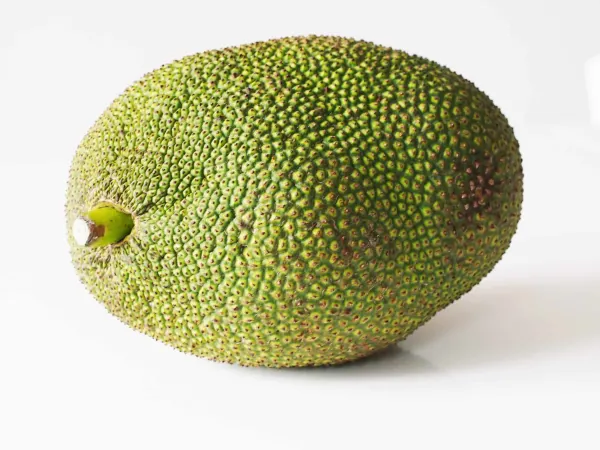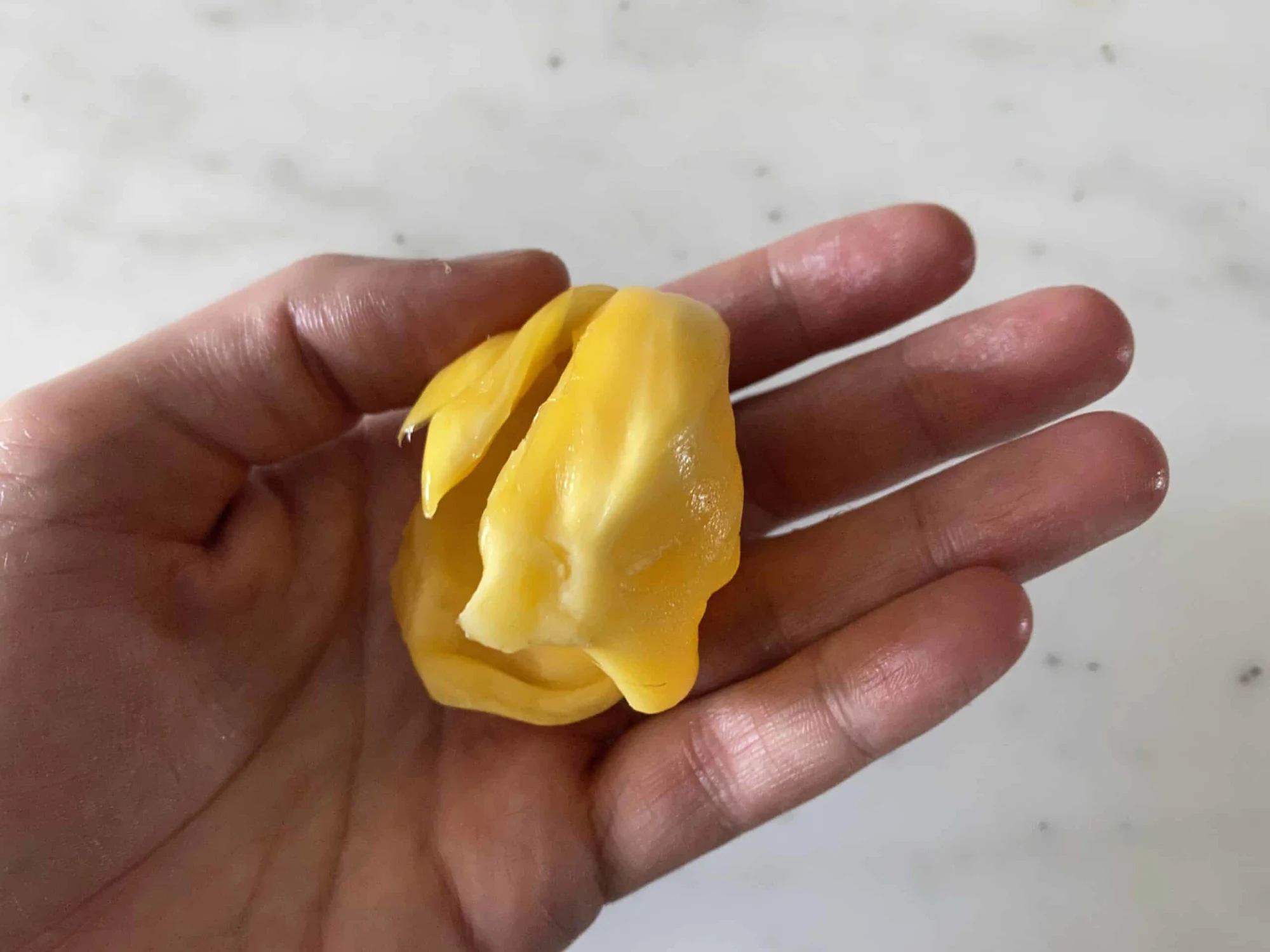Jackfruit
Fruit
Age Suggestion
6 months
Iron-Rich
No
Common Allergen
No

When can babies eat jackfruit?
Jackfruit may be introduced as soon as baby is ready to start solids, which is generally around 6 months of age.
Can babies eat jackfruit seeds?
Yes, if the seeds are cooked until soft, membranes removed, and mashed. After boiling or roasting the seeds until soft, peel off the white and brown membranes before preparing for baby. Note that, in addition to the choking risk, uncooked jackfruit seeds contain a compound that is not safe for consumption. Cooking the seeds eliminates the compound and makes the seeds safe to eat.
Jackfruit seeds are also pulverized into flour and are dense with fiber, protein, and polyunsaturated fats to support brain function, as well as plenty of antioxidant benefits.
Where does jackfruit come from?
One of the world’s largest fruits, jackfruit originated in South Asia, where it is known as mít, nangka, panasa, and many other names. Today, jackfruit trees grow across the global tropics, though the majority that is harvested, canned, and shipped worldwide comes from Bangladesh, India, Sri Lanka, Thailand, and other countries in South Asia. People throughout the region learned to cultivate jackfruit in ancient times, harvesting the massive bumpy green fruits from the trunks of tropical evergreen trees. After European colonizers arrived in the 15th century, the plant was introduced to other tropical regions, where it became known as “jackfruit”—an anglicized name from chakka, the Malayalam name for the fruit.
Videos
Is jackfruit healthy for babies?
Yes. Jackfruit offers an array of B vitamins such as B6 and folate, which support neurological development and growth in babies and children. Jackfruit also offers a decent amount of fiber, which supports digestion and the gut microbiome. Although it is not a fat-dense food, jackfruit does contain essential healthy fats important for brain development. Lastly, jackfruit contains carotenoids like beta-carotene, zeaxanthin, and lutein that act as antioxidants, support healthy vision, and may have anti-inflammatory and anti-cancer properties.
The seeds of jackfruit are edible and offer ample protein and starchy carbohydrates to support baby’s growth, as well as some calcium, iron, and vitamin B1.
Can babies eat canned jackfruit?
Yes, in small amounts. Jackfruit is sometimes preserved in brine (which is often high in sodium) or in syrup (which is high in added sugar). Rinsing the fruit before preparing for baby will reduce some sodium or sugar content.
Is jackfruit a healthy meat substitute?
Yes. Jackfruit offers less protein than beef, chicken, pork, and other meats, but it is a perfectly healthy substitute in foods for babies. Cuisines across South Asia have long featured jackfruit as a means to add flavor, heartiness, and nutrition in lots of different types of dishes. For example, in the Bengla language, young jackfruit is sometimes called gach patha which loosely translates to "tree meat"—an apt description given how the unripened fruit absorbs flavor and mimics the texture of animal flesh in cooking. Just pay attention to the food label when purchasing jackfruit in cans or containers. Choose brands with low sodium (less than 100 milligrams of sodium per serving) and take care to safely introduce any common allergens listed on the label.
Is jackfruit a common choking hazard for babies?
Yes. Jackfruit flesh can be challenging for babies to chew. To minimize the risk, remove the seeds, and offer cooked jackfruit or fresh fruit that has been chopped or pulled into shreds. If you would like to serve the seeds, be sure to cook until soft, remove the membrane, and mash. As always, make sure you create a safe eating environment and stay within an arm’s reach of baby during meals. For more information on choking, visit our sections on gagging and choking and familiarize yourself with the list of common choking hazards.
Is jackfruit a common allergen?
No. Allergies to jackfruit are rare. However, jackfruit has infrequently been reported to trigger severe reactions in some individuals with latex and birch pollen allergies. Individuals with Oral Allergy Syndrome who are allergic to birch pollen may also be sensitive to jackfruit. Oral Allergy Syndrome typically results in short-lived itching, tingling, or burning in the mouth and is unlikely to result in a dangerous reaction. Cooking jackfruit can help minimize the reaction.
As you would when introducing any new food, start by offering a small quantity for the first few servings. If there is no adverse reaction, gradually increase the quantity over future meals.
Recommended Guide: Introducing Allergens
Can jackfruit help baby poop?
Yes. Jackfruit pulp is about 80% water and also contains a fair amount of fiber, which together can help promote soft stools. Jackfruit seeds are an amazing source of fiber, particularly insoluble fiber which can help bulk up bowel movements and promote bowel regularity. Note that pooping patterns can vary significantly from child to child. Be sure to talk to your pediatric healthcare provider if you have concerns about baby’s pooping and digestive function.
What are recipe ideas for cooking with jackfruit?
Fresh jackfruit is eaten at different stages of ripeness. When jackfruit is young and green, the unripe bulbs are cream-colored, firm, and neutral in flavor. This is the type of jackfruit often marketed as a “meat substitute,” as it does a great job of soaking up flavor from your family’s favorite sauces. It can also be shredded to use in salads, slaws, and stir-fries—or stuffed into tacos or roasted vegetables. If you are using canned jackfruit to prepare a sweet or savory dish, consider what it is preserved in. While draining and rinsing canned jackfruit likely removes some of the sodium or sugar, it won’t remove all of it, so jackfruit preserved in brine will add a bit of a salty flavor to a dish, while jackfruit preserved in syrup will retain some sweetness. As jackfruit matures, the interior bulbs deepen in color and sweetness, developing a flavor that resembles mango and pineapple. Once peeled and de-seeded, the sweet bulbs can be eaten fresh out of hand or minced into chutneys and salsas. Ripe jackfruit is also a popular flavor in desserts like halo-halo from the Philippines and chakka pradhaman—a popular coconut rice pudding seasoned with cashews, raisins, and spices in the Kerala state of India.
★Tip: Fresh jackfruit releases an extremely sticky sap once it is cut open. Before you slice, place the fruit on parchment paper, waxed paper, or foil to protect your cutting board and coat your hands and knife with oil (coconut oil works well) to prevent the sap from sticking to your tools.
How do you prepare jackfruit for babies with baby-led weaning?
Every baby develops on their own timeline, and the suggestions on how to cut or prepare particular foods are generalizations for a broad audience.
6 to 9 months old:
Finely chop the bulb (seed removed) and fold the fruit into a soft, scoopable food or cook the deseeded fruit until completely soft and mushy. If you have a whole jackfruit on your hands, boil or roast the seeds until soft, remove the membranes, then mash. You can also shred and cook the bulbs of young green jackfruit to stir into coconut curry, moong dal, or your favorite stew to share with baby.
Jackfruit flour can be used to cook idli, roti, and pancakes, but try to avoid processed jackfruit products with lots of sodium and sugar (pre-packaged meat alternatives, chips, ice cream, juices, and pickles) until after the first birthday.
9 to 12 months old:
If baby’s pincer grasp (where the thumb and forefinger meet) has developed, try moving down in size and offer bite-sized pieces of a bulb of ripe jackfruit. Alternatively, you can continue to finely chop or shred jackfruit to stir into a soft, scoopable food for baby. You can also continue to serve cooked and mashed jackfruit seeds (membranes removed).
12 to 24 months old:
Continue to serve bite-sized pieces or shreds of ripe jackfruit, either on their own or as part of savory and sweet shared meals. Once your toddler is taking accurate sized bites and is no longer stuffing food, you can move back up in size to a full fruit bulb, with the seed removed. If the fruit gets bitten down to a size that makes you uncomfortable, simply remove it and replace with a fresh bulb. At this age, you can offer cooked, soft jackfruit seeds, cut in half (membrane removed). This is also a great age to encourage self-feeding with utensils. If toddler needs help, simply pre-load an age-appropriate fork or trainer chopsticks with bite-sized pieces of jackfruit, and lay it next to the food for the child to pick up. Alternatively, pass the utensil in the air for toddler to grab from you.

After cutting a circle around the stem, cut a diagonal incision and start pulling back the fruit skin to expose the fruit fibers and pods. ...
Pulling the fruit pods from the fibrous flesh
Avoid the common pitfalls that can lead to picky eating. See our Do’s and Don’ts of Raising a Happy, Independent Eater.
Written and reviewed by these specialists
J. Truppi, MSN, CNS. Certified Nutrition Specialist®
V. Kalami, MNSP, RD, CSP. Board-Certified Pediatric Dietitian & Nutritionist.
K. Grenawitzke, OTD, OTR/L, SCFES, IBCLC, CNT. Pediatric Feeding Therapist.
S. Bajowala, MD, FAAAAI. Board-Certified Allergist & Immunologist (allergy section)
R. Ruiz, MD, FAAP. Board-Certified General Pediatrician & Pediatric Gastroenterologist
Expert Tips Delivered to Your Inbox
Sign up for weekly tips, recipes and more!
The content offered on SolidStarts.com is for informational purposes only. Solidstarts is not engaged in rendering professional advice, whether medical or otherwise, to individual users or their children or families. No content on this site, regardless of date, should ever be used as a substitute for direct medical advice from your doctor or your medical or health professional, nutritionist, or expert in pediatric feeding and eating. By accessing the content on SolidStarts.com, you acknowledge and agree that you are accepting the responsibility for your child’s health and well-being. In return for providing you with an array of content “baby-led weaning” information, you waive any claims that you or your child may have as a result of utilizing the content on SolidStarts.com.



